An Original Stone Eagle Comes Home to Penn Station in NYC
A 7,500-pound eagle sculpture from the top of the original 1910 Penn Station building has been returned after years in hiding!


Chelsea is one of New York City’s most hip and artistic areas, thanks to its prominent arts district, The High Line, Chelsea Market, and a number of long-time institutions that helped build Chelsea into the attractive neighborhood it is today. The bustling area in the southwest of Manhattan has had quite a storied past, from deadly riots to the “West Side Cowboys” to a two-century-old Masonic Lodge.
Chelsea has been a desirable neighborhood since the 1750s when Thomas Clarke, a British Captain, purchased waterfront property and named his estate “Chelsea” after a soldiers’ home near London. Originally, the “neighborhood” was a ten-square-block plan consisting of what is today the area between Eighth and Tenth Avenues, and 19th and 24th Streets and has expanded since. Chelsea enthusiasts often cannot agree on just where Chelsea is, with some saying from 14th to 30th between Sixth Avenue and the Hudson River — and others very much disagreeing. Beyond geography, we offer you sixteen secrets of Chelsea.
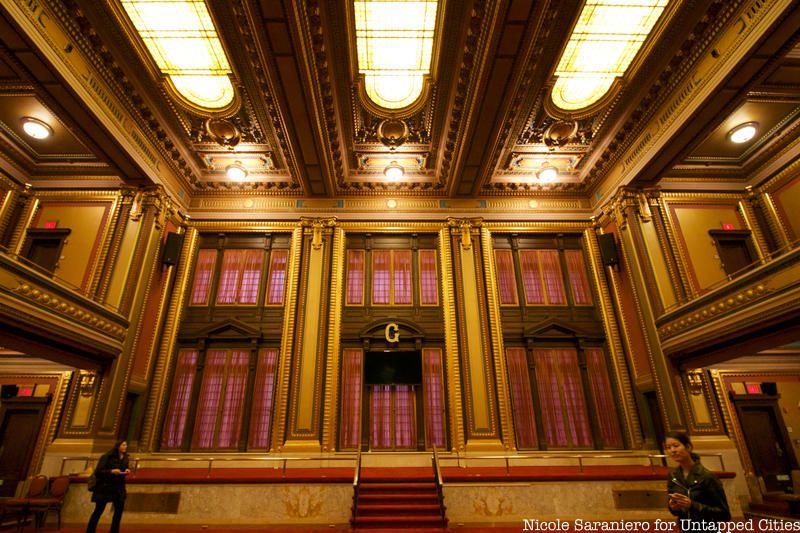
The Grand Lodge of New York is the largest and oldest independent organization of Freemasons in New York. Founded December 15, 1782, the Grand Lodge has jurisdiction over around 60,000 Freemasons — fraternal organizations whose origins trace back to local stonemason guilds. The historic structure at 23rd Street and 6th Avenue has hosted various blood drives and charitable events, as well as the New York Masonic Safety Identification Program.
It is believed that Freemasons first settled in the American colonies around the 1730s. St. John’s Lodge’s in New York City, which was chartered in 1757, is the oldest operating Lodge under the jurisdiction of the Grand Lodge, and it holds the Bible upon which George Washington took his oath of office. The Masonic Hall was built in 1911 by architect Harry P. Knowles, a Master Mason himself, but the current lodge meeting rooms were restored by the interior restaurateur Felix Chavez from 1986 to 1996.
The rooms are all deceptively painted plaster meant to resemble higher quality materials. The modern hall had replaced an earlier Second French Empire Style building, which was considered outdated by the time it was torn down. Historical figures such as Robert R. Livingston, DeWitt Clinton and Stephen Van Rensselaer all served as Grand Masters of the lodge.

Although much of the research on the Manhattan Project took place at Columbia University, Chelsea also played a small but significant role in the development of the atomic bomb. On West 20th Street, three buildings once made up the Baker and Williams Warehouses, which housed thousands of tons of uranium. The federal government in the late 1980s and early 1990s cleaned the buildings of residual uranium, removing more than a dozen drums of radioactive waste.
The Baker and Williams Warehouses were used by the Manhattan Engineer District in the early 1940s to store uranium that had been shipped in secret to the nearby Hudson River docks. The uranium came from the Eldorado Mining and Refining Limited Company in Canada, which operated in relative secrecy. By 1946, over 4,000 tons of ore concentrate containing 1,100 tons of uranium oxide had been delivered to the Manhattan Engineer District. After being stores at the warehouse, the uranium would be sent to government facilities performing nuclear research.
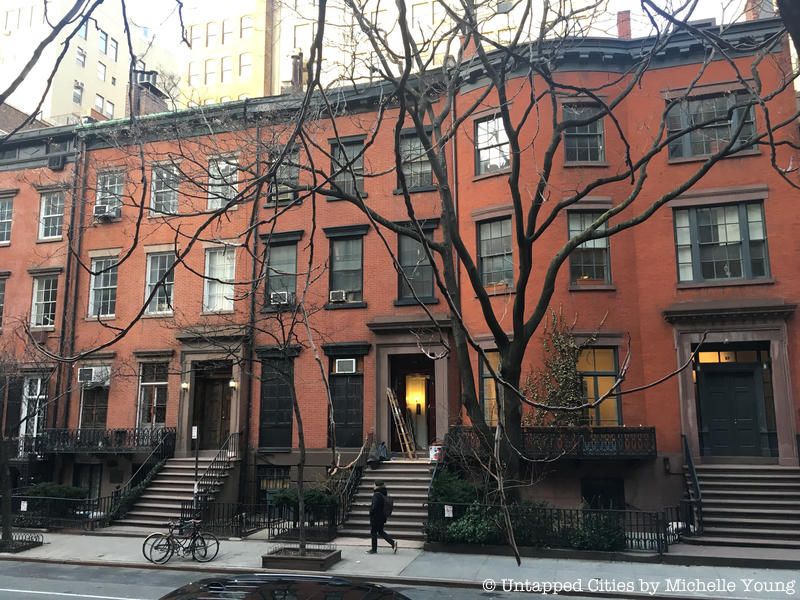
19 West 16th Street in Chelsea looks like a classic Greek Revival brick townhouse with four floors and a stoop that goes up to the parlor level. It blends in perfectly within a stretch of similar row houses. But the townhouse is actually a Tibetan Buddhist monastery called Yeshe Nyingpo, founded in 1976 by His Holiness Dudjom Rinpoche. Rinpoche, who lived from 1904 to 1987, was appointed by His Holiness Dalai Lama XIV (the current Dalai Lama) as the “the first supreme head of the Nyingma tradition of Tibetan Buddhism.”
In addition to a strikingly ornate interior filled with colorful tapestries, carpets, and sculptures, there is a throne used only for the Dalai Lama, who has visited during his trips to New York City. In 2018, the New York Landmarks Conservancy awarded a $3,000 matching grant to Yeshe Nyingpo, part of 17 Sacred Sites Grants given by the organization $279,500, to restore the double-leaf mahogany front door.

The General Theological Seminary has a stunning campus on the superblock bounded by 21st Street to the North, 20th Street to the South, 9th Avenue to the East and 10th Avenue to the West. You might miss it because it’s both elevated from the street and surrounded by walls. In 1817, the General Convention of the Episcopal Church decided to establish a “general theological seminary,” in New York City, that would serve the entire Episcopal church. Today, gorgeous historical buildings with stained glass and other details surround a lush courtyard. The seminary even had its own manhole cover design! The General Theological Seminary has been one of the main venues for the annual Chelsea Music Festival.
Some notable buildings at the General Theological Seminary include The Chapel of the Good Shepherd. Consecrated, whose tower is modeled after Magdalen College at Oxford and the former Hoffman Hall, which is now the High Line Hotel. The Hall was used as a filming location in a scene from Billions.

Before Chelsea Market was Chelsea Market, it was the headquarters of the National Biscuit Company, or Nabisco. The factory officially opened in 1890 when eight bakeries came together to create one super-bakery and continued to expand until 1958 when the corporation left for the suburbs. In 1912, Nabisco invented arguably its most successful product — the Oreo cookie. Lead food scientist Sam Porcello created the recipe, which has remained virtually unchanged over a century later. The company also produced classic products such as Saltines, Vanilla Wafers, Fig Newtons, and Barnum’s Animal Crackers.
Many remnants of the original Nabisco Factory still remain on site. Upon entering Chelsea Market from 9th Avenue between 15th and 16th Streets, you can see a brass Nabisco plaque dating back to 1898, the year the New York Biscuit Company and the American Biscuit and Manufacturing Company from Chicago overcame their rivalry to join and form Nabisco. A display case is filled with assorted vintage Nabisco memorabilia, including old Saltines tins, vintage advertisements, and even a clock. You can also view some of the original Nabisco murals, including the mascot of a boy in a raincoat and an advertisement for Oreos. The hallway leading out onto 10th Avenue is lined with mementos from Chelsea Market’s past and present, including black and white photographs of the old elevated railroad.
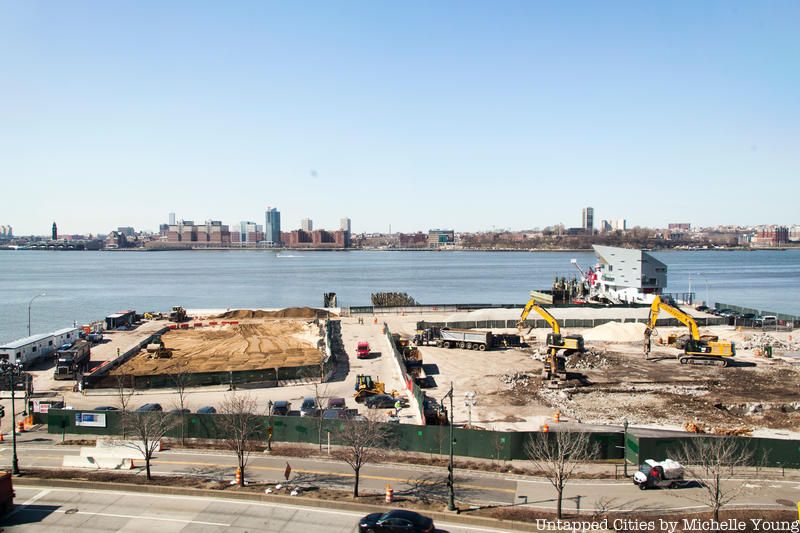
On April 12, 1837, New York City’s 13th Avenue was created after New York State Legislature passed an act to “establish a permanent exterior street in the city of New-York along the easterly shore of the North, or Hudson’s River.” The avenue was to extend from West 11th Street all the way up to 135th Street in Harlem and constructed out of excavated land from the north of the city in upper Manhattan. But even though the avenue was established through a state act, construction never really got anywhere. At its peak, it extended from W 11th Street up to only W 25th Street, never making it further than Chelsea. By 1874, it was reported by the New York Times that the lower regions of the avenue were a “dreary waste” home mostly to lumber yards, saloons, and city dumps.
At the turn of the 20th century, New York City began to focus more on improving the conditions of its ports instead of worrying about getting a whole other avenue built. Until a few years ago, only a single block remains of 13th Ave, known as Gansevoort Peninsula where there’s a building belonging to the city’s sanitation department. It was the city’s shortest avenue until construction commenced to turn the area into a new part of Hudson River Park that will include a waterfront beach.
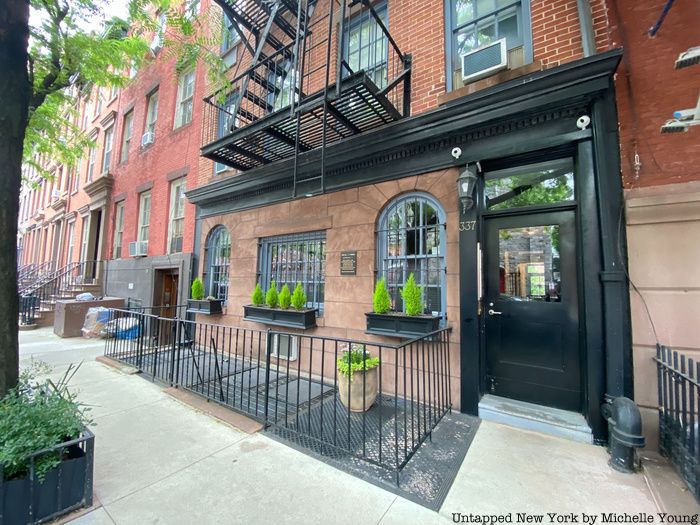
Thomas’ English Muffins are a breakfast time staple, famous for their ‘nooks and crannies’ and horse and carriage advertising. However, despite the name recognition Thomas’ enjoys today, the brand’s history is one of humble New York origin. Samuel Bath Thomas immigrated to New York City from England in 1874 (hence the ‘English’ part of the title) with little to his name and a secret recipe in tow. In 1880, he opened his first bakery in New York at 163 9th Avenue, yet as the muffins boomed in popularity throughout the city and its surrounding areas, Thomas saw it fit to expand to another location. In the early 20th century, Thomas’ purchased the building at 337 West 20th Street to help expand production. The property had an oven already built into its basement, making it a perfect fit for the planned expansion.
However, while the oven may have made 337 West 20th Street an attractive purchase to Thomas, it has since become an old relic that came very close to being forgotten by history. In fact, it took until 2006 for the building’s story to be recovered, and even then, it was by accident. Mike Kinnane and Kerry McInerney were making renovations to their ground floor apartment when they first caught a glimpse of the oven’s hundred-year-old bricks that laid dormant beneath their feet. The couple called on the help of an urban archaeologist and later an engineer from George Weston, the current parent company of Thomas’, to offer an official assessment on their findings. the building’s other most valuable hidden treasure is the tranquil courtyard that sits quietly behind it. Reserved for building residents, the courtyard sits on top of the subterranean oven that the building is now famous for and acts as a small oasis for those that now call ‘The Muffin House’ home. A plaque on the front of the building now denotes its muffin-related history.
Prior to the construction of the High Line‘s elevated tracks, the New York Central freight line ran at street level, giving the stretch of Tenth and Eleventh Avenues the nickname Death Avenue. The moniker comes from the consistent and often fatal incidence of trains colliding with people along the busy thoroughfare. The street-level tracks were used to ship commodities such as coal, beef, and dairy products.
Before the trains were elevated, the New York Central Railroad hired men on horseback armed with red flags to ride in front of the trains to signal their arrival. They came to be known as The West Side Cowboys. However, such cowboys were unable to prevent many further disasters, with some estimates revealing well over 500 deaths just along Eleventh Avenue over the years. The West Side Improvement Project, developed by Robert Moses, eliminated 105 street-level railroad crossings and ultimately expanded Riverside Park.
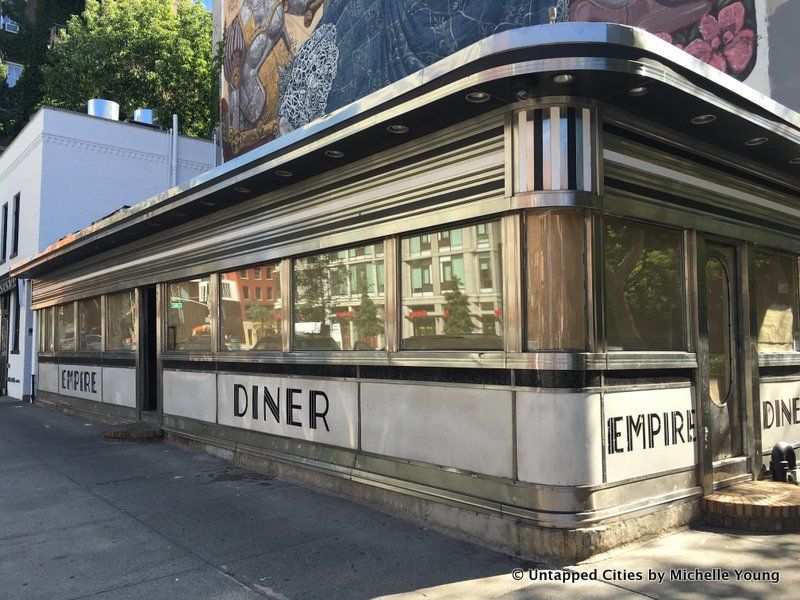
Empire Diner in Chelsea is one of the city’s historic retro diners, and one of the city’s last standalone diners. It was constructed by the Fodero Dining Car Company in 1946. Empire Diner is located at 210 Tenth Avenue and features an Art Moderne exterior that has featured in many films and television programs. However, the diner’s history has not been smooth; it was nearly abandoned after closing in 1976, and the greasy spoon was renovated by three new owners as part of the “Chelsea Renaissance.” Instead of serving traditional diner fare, the owners transformed it into an upscale restaurant with “highbrow-lowbrow fusion.”
After a rather successful run and a few shifts in ownership, the diner closed again in 2010, but just a few months later, Gotham City Restaurant Group opened a new restaurant at the site, the Highliner. The restaurant then reopened under the name Empire Diner in 2014 but shut down again a. year later. Now, Empire Diner serves a rather expensive menu of diner fare and American bistro cooking, featuring newer additions such as small plates and mains including cavatelli with truffle butter and broccolini pesto, fried chicken, and lobster BLTs.
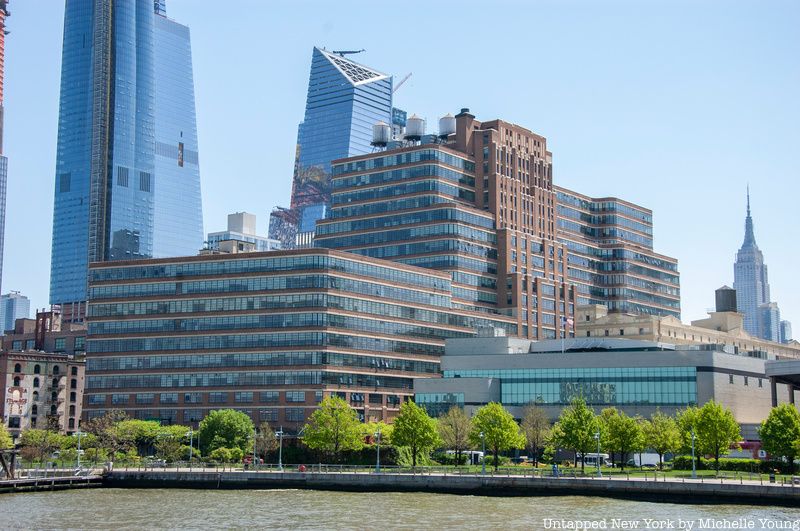
Sitting atop the freight transport center of the city is one of New York City’s oldest “modern” buildings, The Starrett-Lehigh Building on West 26th Street. It was built in 1931 as a transportation and distribution center for the Starrett real-estate interests and the Lehigh Valley Railroad. Built during a time when almost everything was transported by train — Chelsea was also one of the city’s most lucrative shipping and containment centers — the Starrett-Lehigh Building was constructed as a hub for freight transportation and used primarily to store and process items in transit.
The building is supported from the inside by steel beams because its walls, made entirely of glass, cannot directly support their own weight. The building also takes up an entire city block, one of only a few in the city. The site’s floor plan consists of a nine-floor wing on the west, an 18-floor wing on the east, and a 19-floor middle section.The building used enormous 30-foot elevators to lift trucks and freight cars, brought in from the Lehigh Valley Railroad freight yard to the upper floors of the building. The freight yard is now no longer used, but its elevators remain. The building contains offices and design studios, with panoramic views of the Hudson River, which just under a century ago was once brimming with shipping containers. Fun fact: The Untapped New York offices were located inside the Starrett Lehigh building before!
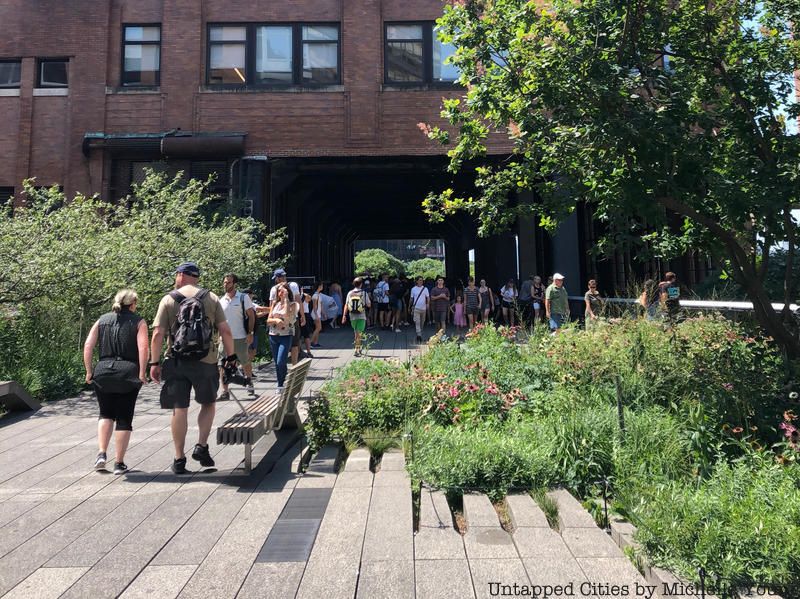
Although many may think that The High Line‘s concept of transforming old railroad tracks into a park was pioneered in Chelsea, The High Line took inspiration from a similar project in Paris, The Coulée Verte René-Dumont is located in the 12th arrondissement of Paris, built in 1993 out of a repurposed railway. It follows the old Vincennes railway line and crosses an elevated viaduct called Viaduc Des Artes as it reaches the Bastille. The High Line, the Coulée Verte’s American counterpart, was meant to have connecting retail space under it, but plans were discontinued after spaces under the park became privatized.
For years, the elevated railroad in New York City was simply a site popular to urban explorers, but there were many efforts in the 1980s to demolish the entire railway, which many viewed as a waste of space. Mayor Giuliani’s administration slowly started to dismantle parts of the tracks and put in plans to officially demolish it, yet many activists pushed to transform the archaic tracks into some kind of public space. When the project to renovate the railway was green-lit in 2003, Friends of the High Line held a design competition trying to find the best approach to reinventing the space, and although the Paris-inspired design ultimately attracted the most attention, there were plenty of other rather strange designs considered, such as making the entire stretch of the railroad into a pool.

Located at 222 West 23rd Street, Hotel Chelsea is a New York City landmark made famous by many of its residents — and their strange stories. The 12-story red-brick building was built between 1883 and 1885 as one of the city’s first private apartment cooperatives, but it was converted into a hotel in 1905. Philip Hubert, who created many co-ops throughout New York City including some along Madison Avenue, also designed what would become Hotel Chelsea, incorporating flower-ornamented iron balconies and a grand staircase into its Queen Anne Revival-style design. The co-op quickly went bankrupt, though, due to economic panics, the relocation of the city’s Theatre District, and the rapid development of Upper Manhattan. Most of the historic structures from the Theatre District have since been destroyed.
Soon after, it was reopened as a hotel, which in its early years provided a home to figures such as Mark Twain and O. Henry. Over the years (and after going bankrupt again in 1939), the hotel hosted dozens of celebrities including Arthur Miller, Stanley Kubrick, Jimi Hendrix, Robert Mapplethorpe, Patti Smith, and many Beat Generation poets. Arthur C. Clarke wrote 2001: A Space Odyssey while staying at the Chelsea, while Andy Warhol shot his film Chelsea Girls here. Leonard Cohen wrote about Janis Joplin’s affair in his songs “Chelsea Hotel” and “Chelsea Hotel #2.” On the more grim side, Dylan Thomas became ill and later died of pneumonia while staying in Room 205, while Nancy Spungen, the girlfriend of Sid Vicious of the Sex Pistols, was stabbed to death there in 1978.
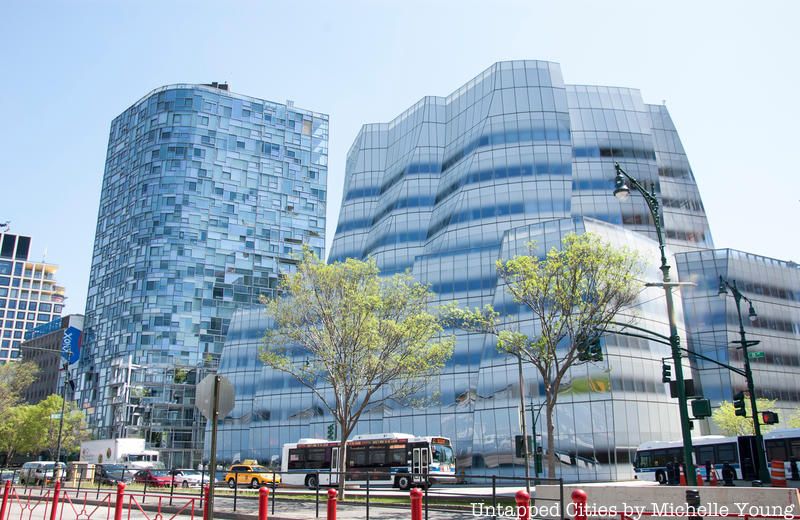
For decades, Frank Gehry had been one of America’s most famous architects with no prominent presence in New York. Gehry had led numerous projects in New York, but a significant number of them had failed: A replacement for Madison Square Garden, a redesign of One Times Square, an Ian Schrager hotel on Astor Place, the new New York Times headquarters, the renovation of Lincoln Center, and a downtown Guggenheim. It wasn’t until 2003, though, that the Gehry “curse” was broken — in Chelsea.
Barry Diller, the CEO of IAC, a holding company of internet-related businesses, spent a day with Gehry in Los Angeles to start plans on a site on West 18th Street. Diller, who wanted the building to be white, wanted it to stand out as a memorable headquarters building. In 2007, Gehry’s first successful design in New York was completed, and it sure was memorable. The large base consists of twisted tower sections packed together, a pattern mimicked on the more narrow second level. Although Gehry planned for the facade to be of wrinkling titanium, Diller insisted that it be covered with smooth glass; each of 1,437 milk-white glass panels is a slightly different shape. Gehry would go on to successfully design 8 Spruce Street (New York by Gehry) in the Financial District, a 76-story skyscraper and one of the tallest residential towers in the world. Across the street is Chelsea Piers, a place you can mentally mark where the greatest ocean liners once docked (and where some major shipwrecks took place
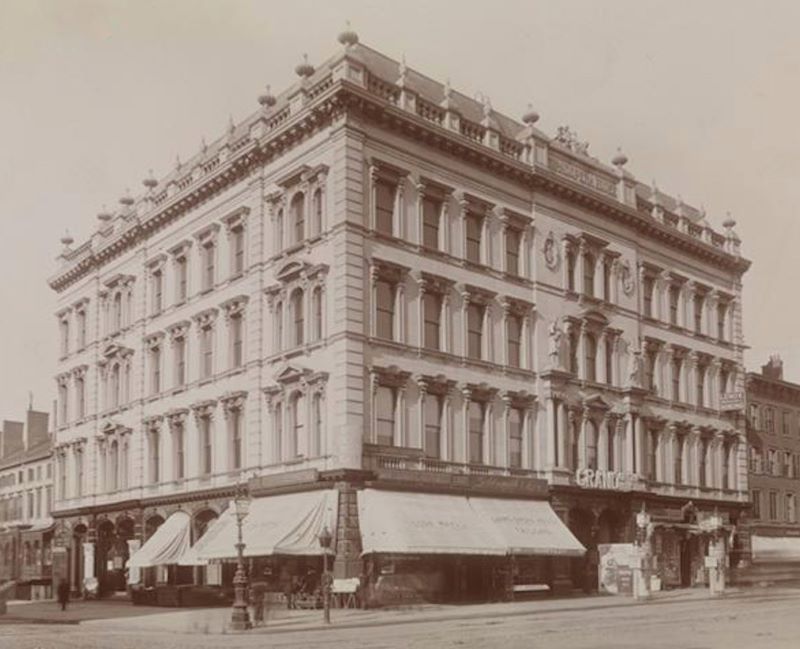
Pike’s Opera House, renamed the Grand Opera House, was a theater on the northwest corner of 8th Avenue and 23rd Street in Chelsea. Pike’s Opera House was built on the former site of Clement Clarke Moore’s home “Chelsea,” which gave inspired the name of the neighborhood. Built in 1868, the building survived until 1960 as an RKO movie theater, but it was replaced by the housing development Penn South. The grand auditorium, which could accommodate 1,800 people but often was packed with double the capacity for popular performances, opened with Verdi’s Il Trovatore and followed with seven Jacques Offenbach operettas.
However, just four years after opening, the opera house was the site of a brutal murder. Jim Fisk and Jay Gould bought Pike’s Opera House in January 1869, which led to a more diverse repertoire. However, after Fisk and Gould unsuccessfully tried to corner the gold market — leading to the 1869 Black Friday gold panic — Fisk barricaded himself in the opera house. The opera house had also served as headquarters for the Erie Railway. Fisk was shot by his partner Edward S. Stokes after Stokes found out that Fisk had indicted him for attempted blackmail. A few years after Fisk’s murder, the theater changed ownership a few times, and soon after Buffalo Bill and blackface performances of Uncle Tom’s Cabin were put on.
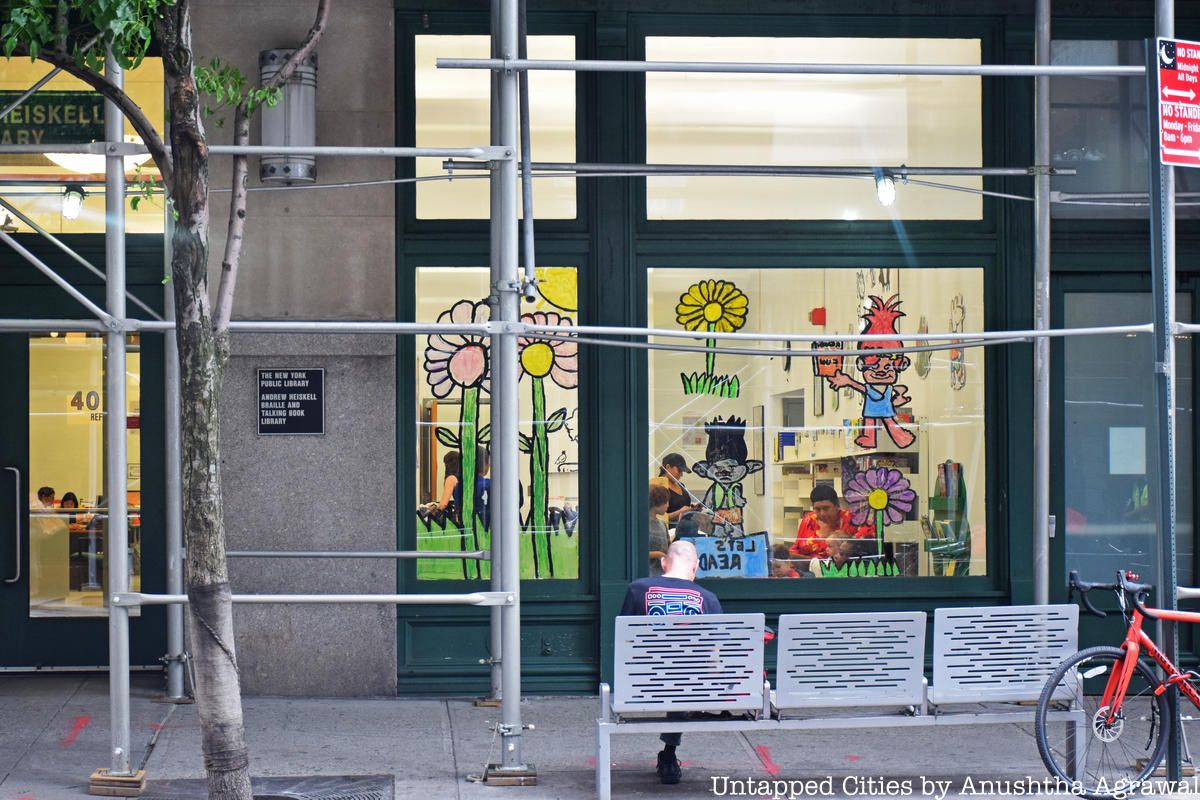
Skirting the eastern edge of Chelsea is the Andrew Heiskell Braille and Talking Book Library, which has one of the largest openly browsable circulating Braille collections in the United States. It was founded in 1895 as the New York Free Circulating Library for the Blind, and it was renamed in 1991 in honor of former chairman and CEO of Time Inc., known for his philanthropy for organizations including the New York Public Library. It is one of the city’s only places where blind or hard of seeing people can sift through new releases, magazines, maps, and artworks.
According to NYC Go, the institution had 13,160 Braille titles, 33,636 books on digital cartridge and 1,970 large-print books as of 2017. The library has hosted twice-weekly Braille study groups, book club meetings, creative writing workshops, and performances by the New York Opera Forum, with large-print and Braille plot summaries supplied. Every computer in the library is equipped with screen-reading programs for navigating the web or performing other tech tasks. Visitors who come from all over the country can learn more about getting around in the city from resources such as Braille maps.

On the more contemporary end, there are a plethora of undergrounds and lesser-known spots to discover in Chelsea. Some of our favorites include Artechouse, an immersive art space below Chelsea Market, the Norwood Club, and the KGB Museum about spycraft. Chelsea also features quite a few speakeasies that pay homage to those from over a century ago. Speakeasies were illicit bars that sold alcoholic beverages during the Prohibition era, many hidden in hard-to-find spots in lower Manhattan. Recently, though, many secret speakeasies have popped up across Manhattan, many hidden behind doors or bank vaults, underneath unassuming buildings, or on the other side of a vending machine.
In the heart of Chelsea is Loulou, a French bistro with a basement speakeasy accessed through a vintage Coca-Cola refrigerator door. La Noxe is a speakeasy hidden inside a subway station, notable for Mediterranean small plates and chic drinks. Raines Law Room is a step back in time to the 1920s; go downstairs and ring the bell to get in and order food and drinks. And Bathtub Gin is hidden behind a coffee shop, offering specialty drinks as well as live jazz and burlesque shows.
Next, check out 22 Must-Visit Spots in Chelsea!
Subscribe to our newsletter